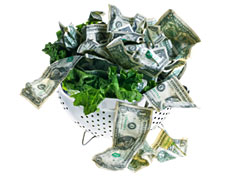
Here in the United States, we grow 44 percent of the world’s corn crop, and 38 percent of its soy. For the great bulk of that massive harvest, we rely on a single region: the Midwestern farm belt. And over the past couple of weeks, torrential rains have hammered that area, at a particularly sensitive time for its grand swath of corn and soybean plants.
An unusually wet spring had already pushed farmers to plant their crops late and forced them to keep some land fallow. With the recent deluge, a bad situation has turned worse. The rains have not only damaged crops, they’ve also washed away untold tons of fertilizer, which leach into groundwater and eventually flow through the Mississippi clear down to the Gulf of Mexico. There, the fertilizer won’t feed crops; instead, in a double blow to food production, it will nourish a vast algae bloom blotting out sea life that would otherwise have contributed to a once-bountiful fishery.
As a result of this soggy situation, corn yields will plummet, the USDA reports [PDF]. And that’s bad news for the billions of people who rely on the global food system for sustenance.
Back in February, a fertilizer executive was already waxing darkly about trends in food production: “If you had any major upset where you didn’t have a crop in a major growing agricultural region this year, I believe you’d see famine,” William Doyle, CEO of Potash Corp. of Saskatchewan, told Bloomberg News.
Mulling over depleted global grain stores, ramped-up U.S. and European mandates for turning food crops into biofuel, and rising demand for grain in Asia, Doyle declared that the global food system had no margin for error. “We keep going to the cupboard without replacing, and so there is enormous pressure on agriculture to have a record crop every year,” he said. “We need to have a record crop in 2008 just to stay even with this very low inventory situation.”
Since that time, we’ve seen images of people in places like Haiti desperately scrounging in garbage dumps for food, because they could no longer afford to buy it. And now comes news that prospects for the coming harvests of corn, soy, and wheat — the holy trifecta of our globalized food system — are looking grim indeed.
When It Rains, It Pours
Think food prices are high? Fasten your seatbelt — and prepare to tighten it. The bad weather combined with dubious federal policies means we’re … well, shucked.
In the past, societies stored grain precisely because agriculture has always been such a fickle food provider. A few decades ago, the U.S. began testing a new theory: sell off grain reserves and let “market forces” ensure there’s enough food for everyone. Our policymakers have become so enamored of the idea that they’ve managed to convince many countries in the global south to do the same — often with the help of the International Monetary Fund and its famed “structural adjustment” packages.
More recently, our leaders have combined the no-grain-storage decree with another, deeply contradictory experiment: using heavy-handed subsidies and mandates (what happened to “market forces”?) to ensure that a large and growing chunk of our farm bounty be turned into car fuel.
Combined, those policies have brought us to the present pass: As our friend the fertilizer executive reminds us, feeding the world now requires that the weather cooperate, every year. That’s a tough row to hoe, given that climate change seems set to make weather patterns increasingly erratic. And as we’re seeing this summer, it doesn’t take much to make things come unhinged.
In response to the rains, investors have driven up corn prices to levels never seen before. By Wednesday afternoon, corn was trading above $7 per bushel — an astonishing 75 percent rise since last June. Just three years ago, a bushel of corn fetched less than $2. The same factors have ramped up soy prices as well.
And the worst may be yet to come. Weather reports suggest that the Midwest’s wet spell may last through the month. If that happens, surviving plants will have a tough time developing deep roots, making them vulnerable to a dry spell later in the summer. If a soggy June turns into a bone-dry July and August, corn and soy prices will likely spike anew.
Meanwhile, wheat prices have held relatively steady — most of the U.S. wheat crop lies outside the area currently under water. But the same factor that pushed global wheat prices to all-time highs last year — a persistent drought in Australia’s wheat belt — may be rearing up again. The New York Times reported recently that a new burst of dry weather in Australia could lead to another shortfall in its wheat output — and push prices back into the stratosphere.
And that’s not all. While conditions are too dry in Australia, Chinese farmers, like their U.S. counterparts, are bracing for hard rain. According to the Times, China’s agriculture ministry “issued an urgent notice to wheat and rice farmers in southern China on Sunday, telling them to harvest as much of their crop as possible immediately in the face of unseasonable torrential rains expected to rake the region for the next 10 days.”
At this point, given how much there already is to worry about, it’s probably best not to think about the new fungal strain that, according to The Wall Street Journal, threatens to eviscerate wheat crops in Africa, the Middle East, and South Asia.
No Piece of Cake
When fertilizer magnate Doyle predicted famine if global agriculture didn’t hit on all cylinders this year, he probably wasn’t talking about the industrial nations of North America and Western Europe. Despite our increasingly enfeebled economy, most Americans still command enough wealth to procure sufficient calories even if prices rise dramatically. Likely, Doyle meant the world’s 850 million people who live in conditions of persistent hunger, mostly in the southern hemisphere. For them — many of whom have been essentially evicted from productive farmland and pushed into cities over the past few decades — spikes in food prices spell devastation.
But here in the United States, too, hard times seem imminent. No one can envy the 10.9 percent of U.S. families who already lacked sufficient access to food as of 2006. That number will surely grow as the economy weakens.

Bad weather and big ag are tossing shoppers around.
And you don’t have to be poor to feel the pinch of higher grocery bills. “You know those complaints you’ve been hearing about high food prices? They’ve just begun,” a commodity trader told The New York Times Thursday.
As the food crisis plays out, we’re likely to hear more and more pitches from agribusiness giants who promise that if we simply play by their rules, everything will be just fine. Just last week, the biotech giant Monsanto — which dominates the global seed markets for corn, soy, and cotton — announced its intention to double yields for its “core crops” by 2030, all the while reducing “by one-third the amount of key resources” required to grow them.
To do so, Monsanto and its allies are stockpiling patents for so-called “climate ready” genes that will ostensibly equip plants to withstand severe weather. “In the face of climate chaos and a deepening world food crisis, the Gene Giants are gearing up for a PR offensive to re-brand themselves as climate saviors,” writes the watchdog outfit ETC Group in a recent report. “The focus on so-called climate-ready genes is a golden opportunity to push genetically engineered crops as a silver bullet solution to climate change.”
If the current crisis has taught us one thing, it’s that food production needs to become more diversified and dispersed, not concentrated ever more tightly into fewer and fewer hands. Here’s my alternative to Monsanto’s vision: Let’s end the biofuel mandates and subsidies — currently eating up around $13 billion per year in taxpayer cash — and invest the savings in grain storage and the infrastructure required to really revive local and regional food production.
Of course, Monsanto can lavish a cool $1.3 million on Washington lobbyists each quarter, and all I’ve got is this stinkin’ column.



